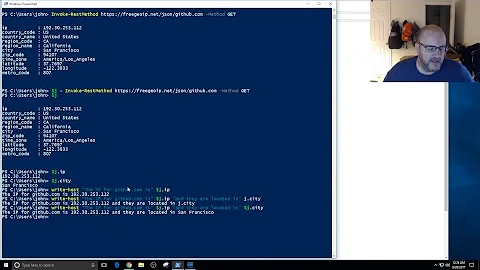What is the difference between Invoke-WebRequest and Invoke-RestMethod?
Solution 1
You can find out by decompiling the Microsoft.PowerShell.Commands.Utility assembly.
Basically, Invoke-WebRequest does not deal with parsing the data all that much. With -UseBasicParsing, it does some Regex-based HTML parsing. Without this switch, it’ll use the Internet Explorer COM API to parse the document.
That’s it. It’ll always attempt to parse HTML.
Invoke-RestMethod on the other hand has code to support JSON and XML content. It’ll attempt to detect an appropriate decoder. It does not support HTML (except for XML-compliant HTML, of course).
Both share the same core logic to make the actual HTTP request. It’s only in result processing that they differ.
Seeing is believing!
PS C:\Users\fuzzy> (Invoke-RestMethod https://httpbin.org/headers).headers
Connection Host User-Agent
---------- ---- ----------
close httpbin.org Mozilla/5.0 (Windows NT; Windows NT 10.0; de-DE) WindowsPowerShell/5.1.15063.483
PS C:\Users\fuzzy> Invoke-WebRequest -UseBasicParsing https://httpbin.org/headers
StatusCode : 200
StatusDescription : OK
Content : {
"headers": {
"Connection": "close",
"Host": "httpbin.org",
"User-Agent": "Mozilla/5.0 (Windows NT; Windows NT 10.0; de-DE)
WindowsPowerShell/5.1.15063.483"
}
}
RawContent : HTTP/1.1 200 OK
Connection: keep-alive
Access-Control-Allow-Origin: *
Access-Control-Allow-Credentials: true
X-Processed-Time: 0.00075101852417
Content-Length: 180
Content-Type: application/json...
Forms :
Headers : {[Connection, keep-alive], [Access-Control-Allow-Origin, *], [Access-Control-Allow-Credentials,
true], [X-Processed-Time, 0.00075101852417]...}
Images : {}
InputFields : {}
Links : {}
ParsedHtml :
RawContentLength : 180
Solution 2
systemcenterautomation.com did a blog post about this. The conclusion:
Invoke-RestMethodis much better at dealing with XML and JSON results, whileInvoke-WebRequestis better at dealing with straight HTML results
Related videos on Youtube
James
Assistant Headteacher at a UK secondary school Creator of MiniTest, an app for online marking and feedback
Updated on September 18, 2022Comments
-
James over 1 year
I've been successfully using
Invoke-WebRequestto post requests to a REST-based API from PowerShell.Invoke-WebRequest -UseBasicParsing https://my-rest-api.com/endpoint -ContentType "application/json" -Method POST -Body $jsonToday I came across
Invoke-RestMethodwhich sounds more aptly-named for what I'm doing. What is the difference, and is there a reason to use one over the other?




